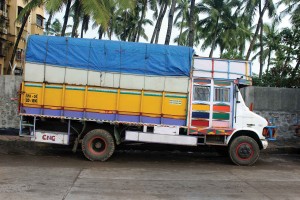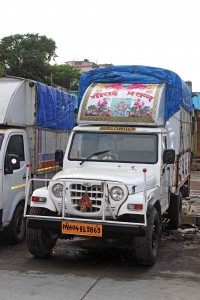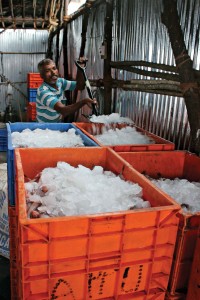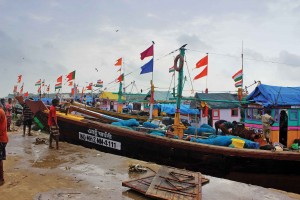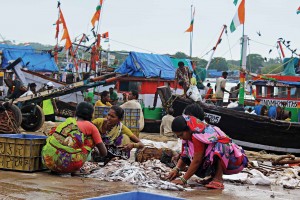Trucks have been transporting fish the world over. What makes it unique is how they ensure that the catch remains fresh until it reaches the market.
Story & photos by: Ashish Bhatia
The ‘Koli’ (fishermen and fisher women) community dotting the seafronts of Mumbai are arguably the originally inhabitants of what where once seven different islands of Mumbai (Bombay). Over 7000 ‘Koli’ families stay at Versova (Vesave). Many have turned to jobs after educating themselves in modern streams. A good deal are however practicing their traditional profession of fishing. Some 30 fishing boats bring a large catch of fish to the Versova jetty, making it one of the major distribution hubs. Trucks built for the purpose ferry fish to various retail markets in Mumbai and Ratnagiri. The beauty of these trucks lies in their construction. For, fish is highly perishable unless stored at freezing temperatures and transported swiftly.
Unlike the air-conditioned container trucks that are used to ferry fish in the advanced markets, the trucks that are used to ferry fish from Versova are different. They are owned by the very ‘Kolis’ that often own the fishing boats as well. A tightly woven community that has specailised in fishing over the generations is as passionate even today. They know their work well, and do what it takes. Entrusting the task of building superstructures of their trucks to local body builders like Rajmal and Jain, the kolis are well aware of what they want. The body builders too are well aware of the requirements of these folks. They are also aware of the trucks the kolis buy.
Buying trucks for the trade
Crates of fish stacked between a film of crushed ice makes for an amount of load. They also call for ample cargo space. So, when Vijay Sathi decided to buy a truck to transport fish, he gave preference to a Tata 608. The year was 1992, and Vijay was taking to the business to get away from boarding a fishing vessel and explore the high seas. His earlier endeavours had helped him earn enough to buy a truck. He was encouraged by other community members who were already into the transportation of fish. Certain of the potential to earn well, he bought Tata 608 cab chassis for Rs. 4.8 lakh. Aware that the container body would define the payload, Vijay turned to a body builder in the fishing town of Vasai to the north of Mumbai. It cost him Rs. 1.35 lakh to get a container body built on the Tata 608 cab chassis. Today, it costs Rs. 2.75 lakh to build a container body avers Vijay. “A majority of transporters procure ready to fit carriers that are procured and assembled at Taloja by body builders like Antony Auto Coach Builders,” he announces. “Stress is on adequate space for the container body superstructure to carry as much crates of fish,” adds Vijay. Pointing at his new stead, a Tata 709, Vijay avers, “Each crate contains 30kg of fish depending on the species and size. A transporter earns Rs.80.” If Vijay is to be believed, much importance is given to the technical specifications of the truck. The engine, the clutch, the brakes, cabin comfort, and more.
In the case of Vijay’s truck, there’s a door and a staircase built into the left side of the superstructure. It facilitates easy access to the cargo hold area states Vijay. The superstructure, made of composite material for good sealing is not exactly the kind where fish is loaded from the rear and the cargo hold area is air-conditioned to preserve the quality. The superstructure of Vijay’s lorry, like the other fish lorries found at Versova, is non-airconditioned. Crushed ice is forced into each crate that does the job of keeping the temperature low. Speed of transport is crucial. The staircase and a bench inside facilitates partial loading and unloading of the cargo.
The Tata 709 is not the only truck that Vijay owns. His enterprise, Gorai Tempo, operates three trucks including a Mahindra Maxx pik-up. Mentions Vijay that his company’s turnover is Rs.12 lakh per annum. Claims Vijay who has been in this business for 23 years that he achieved success on the basis of his dedication and perseverance.
The secret of success
The absence of an air-conditioner brings down cost, it also makes for more cargo space. Fish from Versova is transported to as far as Navi Mumbai, and takes one and a half hour to reach there. The non-air conditioned way of transporting fish helps, claims Vijay. He avers that they use a secret agent in the form of a special salt. Sprinkled on the fish, this salt ensures longevity. This is done at the local warehouse – a cold storage facility. Fish is stashed in plastic containers (crates) and covered with a thick layer of locally produced ice. The loaded crates, when it is time to transport them, are stashed on to the truck. Claims Vijay that stringent quality checks are carried out, both at the start and at the end of the journey. How this is done he does not reveal. Instead, he says that this is what determines his remuneration. If any deterioration in quality is observed, the remuneration takes a hit. This can happen when the truck gets stuck in a traffic jam, or breaks down. Explains Vijay, “For short distances we don’t face problems. In case we have to travel long distances, we halt to replace the ice.”
Rising operational costs
Transporting fish is crucial to the success of the business. Fry and fingerlings are transported from hatchery to pond for stocking. Brood fish are sometimes transported into the hatchery to spawn. Many methods of transporting fish have been developed, including the transportation of live harvested fish to the market. It is surprising therefore, that despite the risks associated with the nature of their cargo and its ability to perish, Vijay and other fish transporters of Versova are not in a hurry to upgrade to advanced transporting technologies. Neither is looking for a reefer truck! Nor are they keen to acquire oxygen cylinders. “Our priority is to keep the operating costs under check,” avers Appu, who gives business to transporters like Vijay. Vijay explains, “Our affinity for Tata trucks over others stems from the confidence of carrying out basic repairs ourselves in case of a breakdown.” He quips that other brands have also begun finding acceptance with them, subject to addressing their requirement. Stopping short of mentioning that they opt for dandy trucks that sustain their tendency to overload, given the nature of their cargo, Vijay states that it is the new crop of sub five-tonne trucks that are currently attracting their attention. “A longer cargo tray assures higher payload carrying capacity, and is the most motivating factor,” says Vijay. He adds, “Trucks like the Eicher Pro 1049 (sub five-tonne) stand a good chance.”
Staying in the business
Keeping operational costs in check has become a crucial part of success for Vijay and his fellow fish transporters at Versova. On a new truck chassis, the operator, instead of mounting a new body opts to mount a refurbished body, states Vijay. This costs much less, he adds. A new body costs upwards of Rs.2.5 lakhs. Also, the rise in diesel prices over the last few years has pushed many fish lorry operators to Compressed Natural Gas (CNG) claims Vijay. Many are increasingly wary of buying a new vehicle. Unique to these fish transporters is their preference for a manual clutch and a powerful engine. Failure or a break down is the last thing that we would want, says Vijay. “It can cost us as much as Rs.40-50,000. This makes us very careful in what we select. We are not particularly fond with anything that is automatic or electronic in nature,” he adds. Trucks with such systems, feels Vijay, are liable to have high operating costs. It gets a little difficult to understand when Vijay mentions that a manual clutch operation ensures optimal power. He states, “It provides us some room to overload.” It is a similar story when it comes to air brakes. Explains Vijay, that air brakes allow for a strong bite and quick retardation, and even when the truck is overloaded. The rigidity of a non-assisted steering, he mentions, enables better manoeuvrability. In the case of tyres, the fish transporters prefer 8.25 size as it supports higher load carrying capacity. “It also raises the height of the vehicle which isn’t a dead giveaway of the load at the time of checks by authorities,” beams Vijay. He concludes, “Apart from an acute business sense, the volatile nature of the business is safeguarded by government tax exemptions us ‘Kolis’ enjoy.”



